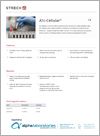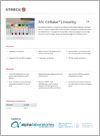Diabetes
HbA1c is an important marker in the management of diabetes
Diabetes mellitus is a group of diseases that affect how the body processes blood sugar (glucose). The underlying cause of diabetes varies by type, but in all cases can lead to excess sugar in the blood which can lead to serious health problems including heart disease, stroke, kidney failure, blindness, amputation of toes, feet or legs, and premature death.
More than 4.9 million people in the UK have diabetes and 13.6 million are at increased risk of developing type 2 diabetes.
Chronic diabetes conditions include type 1 diabetes and type 2 diabetes. Type 1 diabetes can develop at any age, though it often appears during childhood or adolescence. It is thought to be caused by an autoimmune reaction that stops the body from making insulin. In Type 2 diabetes, the more common type, the body doesn’t use insulin well and can’t keep blood sugar at normal levels. It can develop at any age, though it is more common in people older than 40 but can be prevented or delayed with healthy lifestyle changes, such as losing weight, eating healthy food and being active.
Potentially reversible diabetes conditions include prediabetes and gestational diabetes. Prediabetes is often the precursor of diabetes unless appropriate measures are taken to prevent progression. Gestational diabetes occurs during pregnancy but may resolve after the baby is delivered.
Symptoms
Diabetes symptoms vary depending on how much the blood sugar is elevated. In type 1 diabetes, symptoms tend to come on quickly and be more severe. Some of the signs and symptoms of type 1 diabetes and type 2 diabetes are:
Increased thirst
Frequent urination
Extreme hunger
Unexplained weight loss
Presence of ketones in the urine (ketones are a by-product of the breakdown of muscle and fat that happens when there's not enough available insulin)
Fatigue
Irritability
Blurred vision
Slow-healing sores
Frequent infections, such as gums or skin infections and vaginal infections
Haemoglobin A1c (HbA1c) Testing
Some of the glucose in the blood binds to haemoglobin creating glycated haemoglobin known as haemoglobin A1c (HbA1c). The amount of HbA1c formed is directly related to the average concentration of glucose in the bloodstream. Since red blood cells live for 2–3 months, the amount of HbA1c in the blood reflects the average level of blood glucose present during the last 2-3 months.
If diabetes is not well controlled, the blood glucose levels will be elevated, causing an increase in HbA1c levels. This can be indicative of a greater risk of developing diabetes complications.
The HbA1c test results are reported as a percentage with the goal for most adults with diabetes being less than 7%. The HbA1c test can also be used for diagnosis, based on the following guidelines:
A1c levels between 5.7% and less than 6.5% are in the prediabetes range
A1c levels of 6.5% or higher are in the diabetes range
HbA1c testing measures the average blood glucose concentration over the preceding three months, which is the average lifespan of a red blood cell. In contrast, a blood glucose test only measures glucose levels from the previous three to four hours. While daily glucose testing is important to monitor the immediate effect of activities like food intake or exercise, HbA1c testing gives a better indication of long-term glycaemic control and plays a critical role in the diagnosis, assessment and monitoring of diabetes.
Doctors use HbA1c results to monitor the ongoing health of a diabetic patient and a false result could lead to ineffective treatment. In a chronically diabetic patient, that could lead to critical complications, including heart disease, stroke, neuropathy and kidney disease. Accurate diagnosis and monitoring are critical to successful management of this potentially deadly disease.

The Importance of Red Blood Cells in HbA1c Testing
Monitoring Cell Lysis - a Critical Step in HbA1c testing
Using a full process HbA1c control is critical in the HbA1c testing process to provide confidence that the entire HbA1c procedure, from sample preparation to instrument results, is functioning properly and producing accurate results.
Laboratories using frozen or lyophilized controls containing free haemoglobin, will fail to monitor the critical step of lysing the red blood cells (RBCs) in the testing process. If RBCs are not lysed properly, haemoglobin cannot be released from the cell and measured accurately. Controls with a compromised lysing procedure can cause two primary issues: Excessive “clogging” of the analyser column component, that leads to inaccurate results or, inability to provide results, and potential misclassification of patients (normal, prediabetic, diabetic).

Streck Whole Blood Controls
Streck’s HbA1c product line includes a control and linearity panel with intact red blood cells, that is unique because the lysing of the RBCs is also confirmed. They challenge the entire HbA1c procedure , including the lysing of the red blood cells. This important step ensures the entire system, instrument and reagents, is working properly and providing accurate patient results.
Daily use of these whole blood controls provides quality control data for confirming the precision and accuracy of your laboratory’s instruments. Laboratories should validate test methods at least every six months or following changes in lots of critical reagents or system components.


